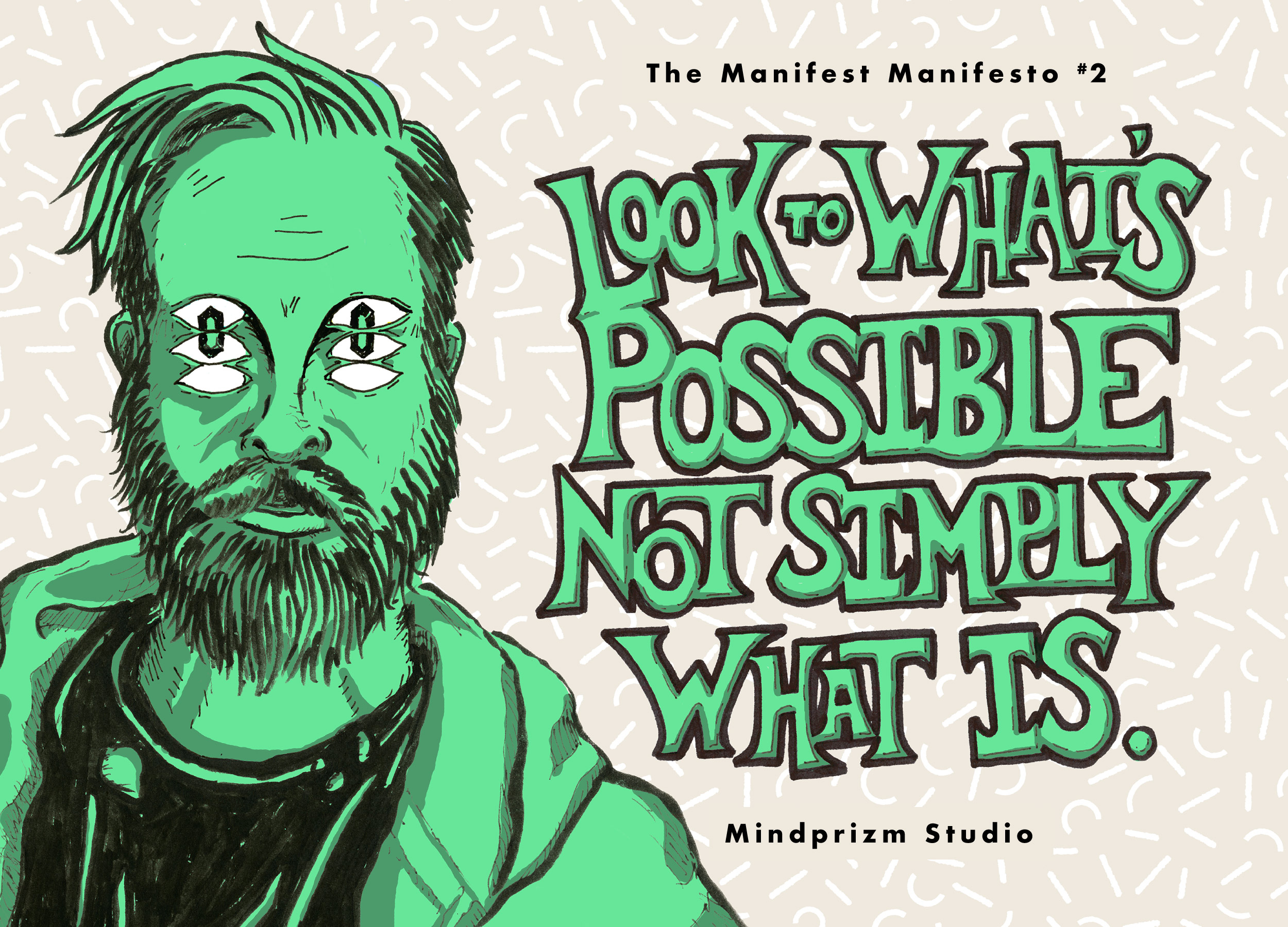The Manifest Manifesto #2: Look to What's Possible, Not Simply What Is
On the surface this may not seem like a big deal because that's just how the real world works, right? But take a closer look at what's actually happening: a series of scenarios where at best we're behaving out of pure instinct and at worst pure reaction. Both will certainly get whatever task finished, but the outcome is typically unsatisfying and has the potential to create future breaks that will later need to be fixed. This cycle then serves to condition an even greater tragedy, an absence of pure inspiration.
This march of monotony is not isolated to any particular field or subject matter.
The Issue Simplified:
Take for example something as simple as composition in graphic design. Set aside brand-standards and visual elements for a moment as we strip things down to their basics. Essentially a wireframe of the data that needs to be present. It's relatively easy to take that information and simply drop it onto a page. Heck, we could even make the headline and subject headers slightly larger for emphasis. But where does that get us? Essentially a barely styled word document. It's technically correct, but also robbed of the potential of what it could be.
That same information can be shown differently by carving out individual pockets in the layout that allow it to be guided into a flow. Throw in some asymmetrical balance to give some unexpected rhythm to the visual communication and things start to get interesting. Upon this scaffolding a brand experience can be built and enriched with unexpected visual flourishes.
So what's the difference between the two approaches? Someone has stopped to consider how the dialogue between the data and viewer should take place. This is magical, but not magic.
The question then becomes how can we get to this mode of thinking with reliability?
First and foremost we need to understand that there are many sizes of problems with varying sizes of solutions and generally speaking there isn't one "right" solution. The important thing is conditioning yourself to stop, dream a little and then follow through to test the merit of the outcome.
On a micro level, when I'm designing something as straightforward as a brand logo and it isn't looking quite right, but I can't quite figure out why I play a mental game that I call Ideal World which consists of taking an element I'm working with and stopping to ask myself: "If all other variables were gone, what would this look like in an ideal world?" Then I move that element to the ideal and adjust everything else around it.
It's simple.
But see what actually happened there? I broke the brute force rinse and repeat of whatever wasn't working and forced myself into action by doing something differently thereby changing the equation. It won't always yield the perfect result, but it will likely watershed into something greater or at least give you confidence in your original solution. This game can be played with any issue or subject matter.
Now, lets tackle a slightly larger problem:
What if you work for a large electric utility and you happen to be in charge of training employees on government mandated Critical Infrastructure Protection. Pretty specific and complex, right?
For those unfamiliar with what most of that introductory sentence means, here's a really simplified background: The power and utility sector are the folks that ensure electricity is generated and that it gets safely and reliably to your home and workplace. In short, they keep the lights on. After the events of 9/11 it became clear to the government that protecting this system from hackers and terrorists was of the utmost importance, after all a major disruption to the electric grid would cripple the country. Thus were born the Critical Infrastructure Protection Standards, a massive set of rules and regulations designed to give every utility guidance on how to keep things secure.
Following so far? Great! Lets hop back to the scenario.
You're in charge making sure the employees in your utility know these standards and are acting in accordance with them. The easiest thing to do would be give each person a copy of the standards (a massive number of pages written in legalese), split the larger group into smaller groups each of which you spend an afternoon going over the high points via a carefully prepared slide deck. You could even build up their egos a bit by telling them that each person is totally capable and in fact responsible for fulfilling their security destiny, then send them on their merry way until next year when you do it all over again.
The problem is this mode of operation has a very low rate of return.
In the real world, no single employee feels ultimately responsible or empowered, because they don't completely understand this massive thing that's suddenly been thrown on them. Who can really blame them? Shouldn't they be focusing on their actual job: helping generate and maintain reliable electricity for the masses?
How would an Ideal World look and how could we get there?
What if the material were more engaging, understandable and memorable. What if each employee felt like they were playing an essential part in a larger, deeper story and that their knowledge of Critical Infrastructure Protection will actually save the world? What if the entire experience was meticulously scripted, designed, animated and performed so that these employees would feel immersed in the material. What if instead of the standards being a chore to learn and understand, they were enjoyable?
Wouldn't that be something?
This is exactly what we did with the Defender Training Simulator and the results were astounding. Thousands of industry employees in utilities across the US have now gone through the training. These individuals now clearly understand their roles and duties as they pertain to Critical Infrastructure Protection which has resulted in a culture of compliance and drop in violations. Most importantly, many of these same employees have begun identifying themselves as "Defenders" because they've adopted the heroic role that they earned in the story. Additionally, the training simulator itself has been the recipient of 4 prestigious international learning awards, and the methodology behind the training is currently the subject of a Kent State study.
The future is already looking brighter for these folks.
None of this would have been possible if the team hadn't stopped, asked themselves what an ideal world would look like, and made adjustments toward that goal. History is written with stories just like this one where dreamers shifted the paradigm. The answers weren't directly in front of them, but somewhere on the horizon to be found and acted upon. That invitation is for you as well.
You owe it to yourself and the world not to let reality get in the way of potential.
-M

